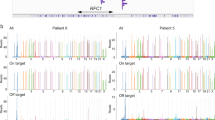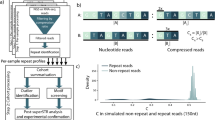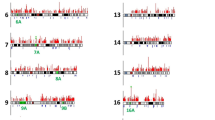Abstract
Trinucleotide repeat expansions have been shown to cause a number of neurodegenerative diseases1–6. A hallmark of most of these diseases is the presence of anticipation, a decrease in the age at onset in consecutive generations due to the tendency of the unstable trinucleotide repeat to lengthen when passed from one generation to the next1. The involvement of trinucleotide repeat expansions in a number of other diseases —including familial spastic paraplegia7, schizophrenia8, bipolar affective disorder9 and spinocerebellar ataxia type 7 (SCA7; ref. 10)—is suggested both by the presence of anticipation and by repeat expansion detection (RED)10–12 analysis of genomic DNA samples. The involvement of trinucleotide expansions in these diseases, however, can be conclusively confirmed only by the isolation of the expansions present in these populations and detailed analysis to assess each expansion as a possible pathogenic mutation. We describe a novel procedure for quick isolation of expanded trinucleotide repeats and the corresponding flanking nucleotide sequence directly from small amounts of genomic DNA by a process of Repeat Analysis, Pooled Isolation and Detection of individual clones containing expanded trinucleotide repeats (RAPID cloning). We have used this technique to clone the pathogenic SCA7 CAG expansion from an archived DNA sample of an individual affected with ataxia and retinal degeneration.
This is a preview of subscription content, access via your institution
Access options
Subscribe to this journal
Receive 12 print issues and online access
$209.00 per year
only $17.42 per issue
Buy this article
- Purchase on Springer Link
- Instant access to full article PDF
Prices may be subject to local taxes which are calculated during checkout
Similar content being viewed by others
References
Warren, S.T. The expanding world of trinucleotide repeats. Science 271, 1374–1375 (1996)
Campuzano, V. et al.Friedreich's ataxia: autosomal recessive disease caused by an intronic GAA triplet repeat expansion. Science 271, 1423–1427 (1996)
Pulst, S.-M. et al.Moderate expansion of a normally biallelic trinucleotide repeat in spinocerebellar ataxia type 2. Nature Genet. 14, 269–276 (1996)
Sanpei, K. et al.Identification of the spinocerebellar ataxia type 2 gene using a direct identification of repeat expansion and cloning technique, DIRECT. Nature Genet. 14, 277–284 (1996)
Imbert, G. et al. Cloning of the gene for spinocerebellar ataxia 2 reveals a locus with high sensitivity to expanded CAG/glutamine repeats. Nature Genet. 14, 285–291 (1996)
Zhuchenko, O. et al. Autosomal dominant cerebellar ataxia (SCA6) associated with small polyglutamine expansions in the α1A-voltage-dependent calcium channel. Nature Genet. 15, 62–69 (1997)
Neilsen, J.E. et al. CAG repeat expansion in autosomal dominant pure spastic paraplegia linked to chromosome 2p21-p24. Hum. Mol. Genet. 6, 1811–1816 (1997)
O'Donovan, M. et al.Expanded CAG repeats in schizophrenia and bipolar disorder. Nature Genet. 10, 380–381 (1995)
Oruc, L. et al. CAG repeat expansions in bipolar and unipolar disorders. Am. J. Hum. Genet. 60, 732–735 (1997)
Lindblad, K. et al. An expanded CAG repeat sequence in spinocerebellar ataxia type 7. Genome Res. 6, 965–971 (1996)
Schalling, M., Hudson, T., Buetow, K. & Housman, D. Direct detection of novel expanded trinucleotide repeats in the human genome. Nature Genet. 4, 135–139 (1993)
Lindblad, K., Zander, C., Schalling, M. & Hudson, T. Growing triplet repeats. Nature Genet. 7, 124 (1994)
Ranum, L.P.W. et al. Spinocerebellar ataxia type I and Machado-Joseph disease: incidence of CAG expansions among adult-onset ataxia patients from 311 families with dominant, recessive, or sporadic ataxia. Am. J. Hum. Genet. 57, 603–608 (1995)
Gouw, L.G. et al. Retinal degeneration characterizes a spinocerebellar ataxia mapping to chromosome 3p. Nature Genet. 10, 89–93 (1995)
Benomar, A. et al. The gene for autosomal dominant cerebellar ataxia with pigmentary macular dystrophy maps to chromsome 3p12-p21.1. Nature Genet. 10, 84–88 (1995)
Ostrander, E.O., Jong, P.M., Rine, J. & Duyk, G. Construction of small-insert genomic DNA libraries highly enriched for microsatellite repeat sequences. Proc. Natl. Acad. Sci. USA 89, 3419–3423 (1992)
Kunkel, T.A., Roberts, J.D. & Zakour, R.A. Rapid and efficient site-specific mutagenesis without phenotypic selection. Methods Enzymol. 154, 367–382 (1987)
Altschul, S., Warren, G., Miller, W., Myers, E. & Lipman, D. Basic local alignment search tool. J. Mol. Biol. 215, 403–410 (1996)
Schuler, G. et al. A gene map of the human genome. Science 274, 540–546 (1996)
David, G. et al. The gene for autosomal dominant cerebellar ataxia type II is located in a 5-cM region in 3p12-p13: genetic and physical mapping of the SCA7 locus. Am. J. Hum. Genet. 59, 1328–1336 (1996)
Marx, J. Putting the human genome on the map. Science 229, 150–151 (1985).
David, G. et al. Cloning of the SCA7 gene reveals a highly unstable CAG repeat expansion. Nature Genet. 17, 65–70 (1997)
Author information
Authors and Affiliations
Corresponding authors
Rights and permissions
About this article
Cite this article
Koob, M., Benzow, K., Bird, T. et al. Rapid cloning of expanded trinucleotide repeat sequences from genomic DNA. Nat Genet 18, 72–75 (1998). https://doi.org/10.1038/ng0198-72
Issue Date:
DOI: https://doi.org/10.1038/ng0198-72
This article is cited by
-
NOTCH2NLC GGC repeat expansion causes retinal pathology with intranuclear inclusions throughout the retina and causes visual impairment
Acta Neuropathologica Communications (2023)
-
Spinocerebellar ataxia 17 (SCA17) and Huntington’s disease-like 4 (HDL4)
The Cerebellum (2008)
-
Bidirectional expression of the SCA8 expansion mutation: One mutation, two genes
The Cerebellum (2008)
-
Bidirectional expression of CUG and CAG expansion transcripts and intranuclear polyglutamine inclusions in spinocerebellar ataxia type 8
Nature Genetics (2006)
-
Spinocerebellar ataxia type 7 associated with pigmentary retinal dystrophy
European Journal of Human Genetics (2004)



